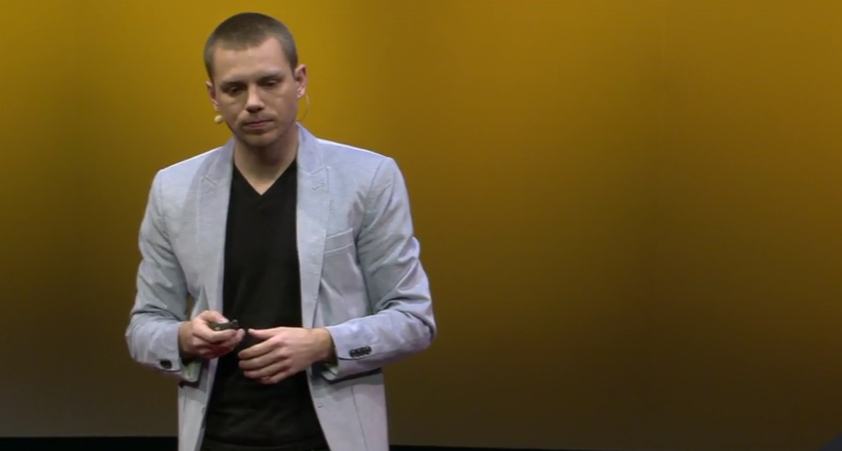So remember, I said 4D. So today for the first time, we're unveiling a new project, which is a collaboration with Stratasys, and it's called 4D printing.
還記得我剛才提到了四維,今天我們首次向大家展示一個新項目,這是和Stratasys公司一同合作的,它叫做4D(四維)打印。
The idea behind 4D printing is that you take multi-material 3D printing -- so you can deposit multiple materials -- and you add a new capability, which is transformation,
4D(四維)打印指的是我們利用多材料進行三維打印——就是我們可以使用多種材料——同時我們又新加一種能力,就是變形,
that right off the bed, the parts can transform from one shape to another shape directly on their own.
一但從車床上下來,這些不同的零部件就可以直接自發的變成其他的形狀。
And this is like robotics without wires or motors.
就像是沒有電線或者馬達驅動的機器人。
So you completely print this part, and it can transform into something else.
所以我們把一個部分完整的打印出來,它就可以自己變成其它的物體形狀。
We also worked with Autodesk on a software they're developing called Project Cyborg.
我們也和Autodesk(歐特克)合作了他們正在開發的Project Cyborg軟件。
And this allows us to simulate this self-assembly behavior and try to optimize which parts are folding when.
這個項目讓我們可以模擬自我組裝這種行為以及優化哪些部件應該在何時折疊變形。
But most importantly, we can use this same software for the design of nanoscale self-assembly systems and human scale self-assembly systems.
但是,最重要的是,我們可以利用同樣的軟件設計納米級的自我組裝系統以及人類生活中的自我組裝系統。
These are parts being printed with multi-material properties.
這些是用多材料屬性打印出來的零件。

Here's the first demonstration. A single strand dipped in water that completely self-folds on its own into the letters M I T. I'm biased.
這是第一個演示,把一條鏈子浸在水里它可以完全自我折疊成字母M.I.T(美國麻省理工學院)。我確實偏心。
This is another part, single strand, dipped in a bigger tank that self-folds into a cube, a three-dimensional structure, on its own.
另外一個演示,把一條鏈子浸在一個大缸里,它會自我折疊變成一個三維結構的立方體,沒有任何人力的影響。
So no human interaction. And we think this is the first time that a program and transformation has been embedded directly into the materials themselves.
我們認為這是首次把一個程序軟件和變形一起直接的嵌入(應用)到材料中去。
And it also might just be the manufacturing technique that allows us to produce more adaptive infrastructure in the future.
或許這將是一種制造技術,能讓我們在未來生產更多的可自我調節的基礎設施設備。












